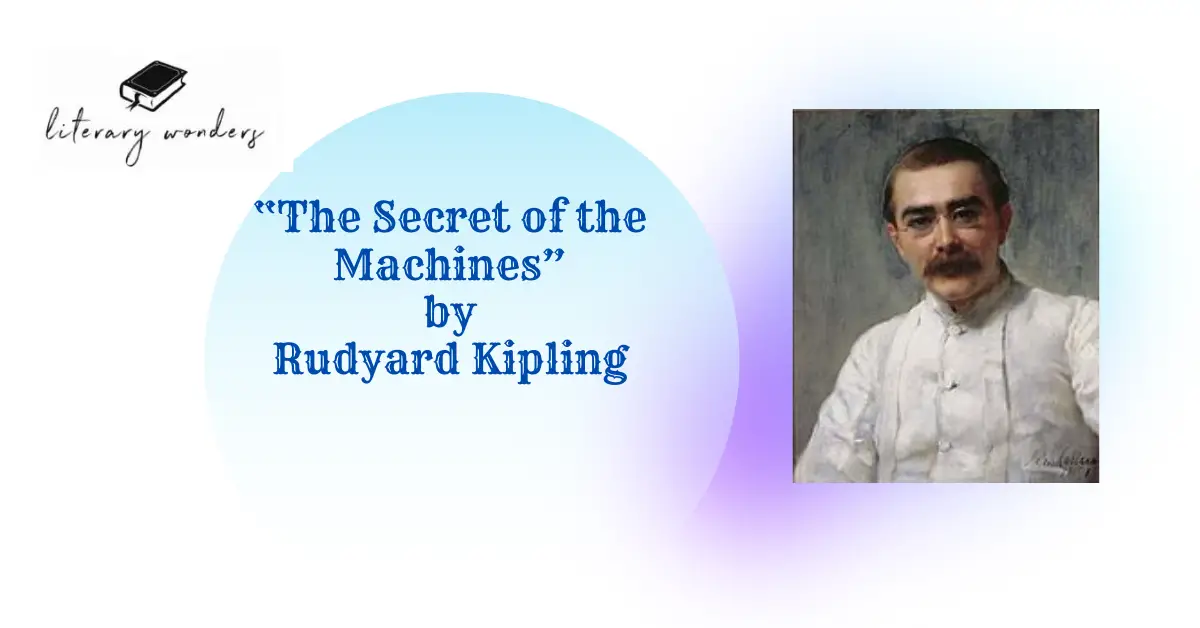Summary of the Poem, “The Secret of the Machines”
- Introduction of “The Secret of the Machines”
“The Secret of the Machines” is penned down by a great British writer and poet, Rudyard Kipling in 1911. It was the time when the great Industrial Revolution took place. This beautiful poem highlights the diverse functionalities of artificial machinery and the comfort their usage has brought to man’s life. Kipling describes although the machines are a wonderful creation, yet they are emotionless. He also states that the misuse of these man-made creations may leads to catastrophic results. However, the poignant comparison between emotionless machines and human nature makes this poem a timeless masterpiece.
Kipling artistically presents both, the advantages and disadvantages of modern technology. He begins this poem while machines are speaking for themselves, proudly describing that they are the product of man’s ingenious mind. The poem goes on describing the detailed process of creating these machines, from melting raw materials to shaping them into useful forms. These machines are powered by coal, water, and oil and are always ready to assist us, even working 24 hours a day. Moreover, they are able to perform tasks that humans can do. The speaker also talks about the practical implications of these machines into many fields along with their positively impacted. For instance, these are a big help in communication and landscaping. It seems that the speaker is impressed by the miraculous tasks that machines can perform. However, the ending of the poem takes a new turn when the speaker compares these artificial creations with human beings. To him, these machines are the product of human brain while human beings are created by God. Therefore, no artificial object can surpass the mastery of God.
- Thematic Analysis of “The Secret of the Machines”
The major themes of the poem include modernity versus nature, man and the modern world and admiration for the technological wonders. The speaker crafts an awful picture of the useful technology, stating their usage has brought sustainability to our lives. He explains how the usage of modern technology has brought revolution to various fields of life, touching almost every sphere. Our reliance on them has grown to a point where we feel vulnerable without them. Although machines were created for our comfort and convenience, we must approach them with caution and rationality. If they are not used in the right way, they can potentially bring disaster upon us.
Analysis of Poetic Elements Used in “The Secret of the Machines”
Rudyard Kipling employs various poetic elements in this poem to convey his ideas about modernity effectively. These devices make the poem more appealing and engaging for the readers. Some of the literary devices used in this poem are as follows.
- Assonance: The first tool is assonance and it refers to the repetition of vowel sounds. Kipling has repeated the sound of /e/ in “We were taken from the ore-bed and the mine” and the sound of /o/ in “And now, if you will set us to our task.”
- Anaphora: This literary device refers to the repetition of same words or expressions in the first part of some verses. Kipling has used this device in the opening stanza of the poem where he repeats world like “we” to emphasize certain points such as;
“We were taken from the ore-bed and the mine,
We were melted in the furnace and the pit—
We were cast and wrought and hammered to design,
We were cut and filed and tooled and gauged to fit.”
- Alliteration: The third literary device is alliteration. It refers to the repetition of consonant sounds in the same line such as the sound of /l/ in “Some water, coal, and oil is all we ask
- Consonance: Consonance is another tool, which refers to the repetition of consonant sounds in the same line such as /t/ in “We were melted in the furnace and the pit” and the sound of /r/ in “We will serve you four and twenty hours a day.”
- Diction: The poem implies descriptive, captivating and symbolic diction.
- Enjambment: Enjambment refers to the continuation of an idea that does not come to an end at a line break; rather, it continues to the next line. For example;
“And take the Western Ocean in the stride
Of seventy thousand horses and some screws!”
- Irony: Irony is a figure of speech in which words are used in such a way that their intended meaning is different from the actual meaning of the words. This device makes the core of the poem. By using irony, Kipling states differences between humans and machines.
- Imagery: Imagery is used to captivate the minds of the readers. Rudyard Kipling has used imagery in this poem such as; “You shall see and hear your crackling question hurled” and “Would you call a friend from half across the world.”
- Rhetorical Question: Rhetorical questions are asked not to find the answers. These questions are deliberately put by writers to make their points clear such as, “Would you call a friend from half across the world?”
- Symbolism: Symbolism is used to associate the plain ideas to more deep and thoughtful approach. The title of the poem is symbolic as it hints that the text is provides a rational comparison between man and the machines.
- Stanza: A stanza refers to poetic line written in a short, compact form. There are eight stanzas in this poem with each comprising different lines.
The analysis shows that these tools have provided deep meanings to the poem. Their appropriate insertion has made it easy to understandable for the readers.
Suggested Readings

